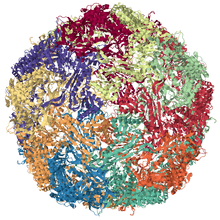Encapsulin nanocompartment

Encapsulin nanocompartments, or encapsulin protein cages, are spherical bacterial organelles roughly 30 nm in diameter that are involved in various aspects of metabolism, in particular iron sequestration which protects bacteria from oxidative stress.[1] In terms of both structure and function, they are quite similar to ferritins.[1] They are composed of several different encapsulin proteins, including the shell protein EncA and the internal proteins EncB, EncC, and EncD.[1] Their structure has been studied in great detail using X-ray crystallography[2] and cryo-electron microscopy.[1]
Encapsulins purified from Rhodococcus jostii can be assembled and disassembled with changes in pH. In the assembled state, the compartment enhances the activity of its cargo, a peroxidase enzyme.[3]
Use as a platform for bioengineering
Recently, encapsulin nanocompartments have begun to receive considerable interest from bioengineers because of their potential to allow the targeted delivery of drugs, proteins, and mRNAs to specific cells of interest.[4][5][6]
References
- 1 2 3 4 McHugh, CA; Fontana, J; Nemecek, D; Cheng, N; Aksyuk, AA; Heymann, JB; Winkler, DC; Lam, AS; Wall, JS; Steven, AC; Hoiczyk, E (1 September 2014). "A virus capsid-like nanocompartment that stores iron and protects bacteria from oxidative stress.". The EMBO Journal. 33 (17): 1896–911. doi:10.15252/embj.201488566. PMC 4195785
 . PMID 25024436.
. PMID 25024436. - ↑ Sutter, M; Boehringer, D; Gutmann, S; Günther, S; Prangishvili, D; Loessner, MJ; Stetter, KO; Weber-Ban, E; Ban, N (September 2008). "Structural basis of enzyme encapsulation into a bacterial nanocompartment.". Nature Structural & Molecular Biology. 15 (9): 939–47. doi:10.1038/nsmb.1473. PMID 19172747.
- ↑ Rahmanpour, Rahman; Bugg, Timothy D. H. (2013-05-01). "Assembly in vitro of Rhodococcus jostii RHA1 encapsulin and peroxidase DypB to form a nanocompartment". The FEBS Journal. 280 (9): 2097–2104. doi:10.1111/febs.12234. ISSN 1742-4658. PMID 23560779.
- ↑ Corchero, José L; Cedano, Juan (2011). "Self-assembling, protein-based intracellular bacterial organelles: emerging vehicles for encapsulating, targeting and delivering therapeutical cargoes". Microbial Cell Factories. 10 (1): 92. doi:10.1186/1475-2859-10-92.
- ↑ Moon, H; Lee, J; Kim, H; Heo, S; Min, J; Kang, S (2014). "Genetically engineering encapsulin protein cage nanoparticle as a SCC-7 cell targeting optical nanoprobe.". Biomaterials research. 18: 21. doi:10.1186/2055-7124-18-21. PMC 4552281
 . PMID 26331071.
. PMID 26331071. - ↑ Tamura, A; Fukutani, Y; Takami, T; Fujii, M; Nakaguchi, Y; Murakami, Y; Noguchi, K; Yohda, M; Odaka, M (January 2015). "Packaging guest proteins into the encapsulin nanocompartment from Rhodococcus erythropolis N771.". Biotechnology and Bioengineering. 112 (1): 13–20. doi:10.1002/bit.25322. PMID 24981030.